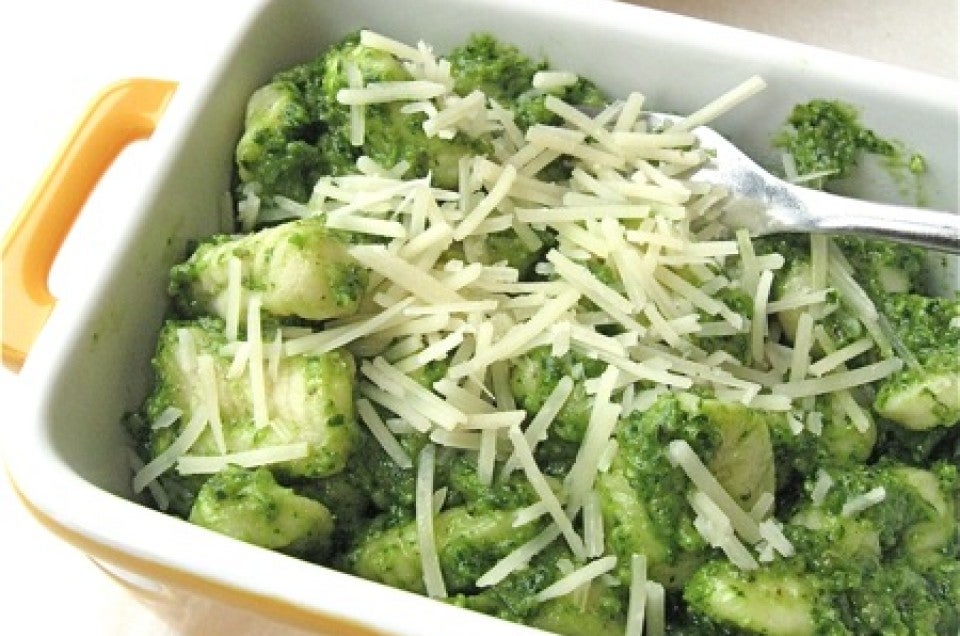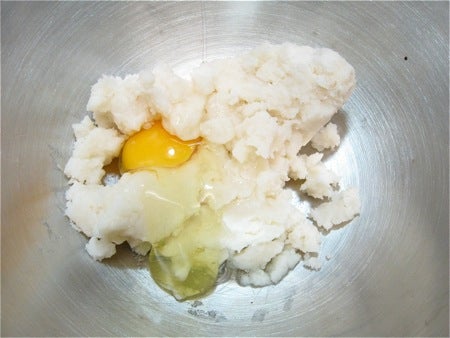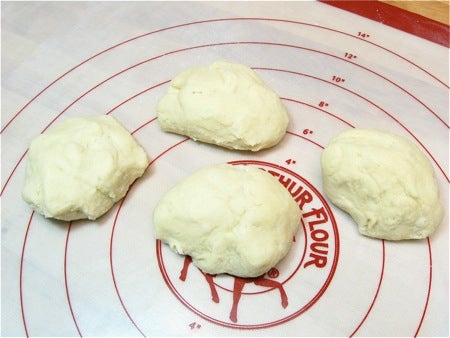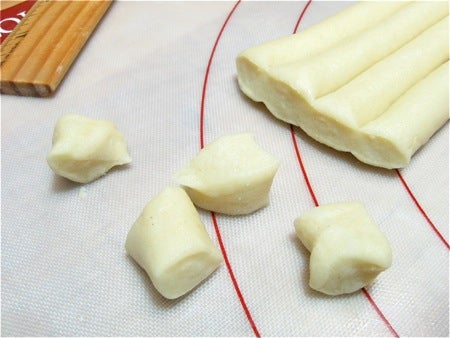


Have you ever enjoyed gnocchi?
If not, get ready for a real treat.
These fat little twists of potato pasta are a kinder, gentler example of the genre. Rather than cooking up like regular pasta – al dente, with a slight “bite” – gnocchi are soft as a pillow. Their slightly indented undersides catch and hold your favorite sauce – marinara, pesto, or a simple mix of olive oil, parsley, and garlic.
They're wonderful baked in a casserole, too, mixed with cream and showered with Parmesan.
Looking at homemade gnocchi – truth be told, looking at ANY homemade pasta – you might say, “No way, that's too much effort. I'll buy it at the store.”
But gnocchi, serendipitously, are extremely easy to make – and often difficult to find at the supermarket. Making your own gnocchi is both desirable, and easy. Just follow the steps below, and you'll soon be enjoying tasty homemade gnocchi regularly.
Oh, and by the way: if you don't know how to pronounce the word gnocchi, think back to being a kid and making fun of someone on the playground:
Nyah nyah nyah!
Or, better, yet, Curly from the Three Stooges: Nyuk nyuk nyuk...
It's NYAWK-ee.
OK, first step: you need about 2 cups (14 ounces) mashed potatoes, or 14 ounces of riced potatoes (baked potato put through a potato ricer).
We made gnocchi using both fresh and instant potatoes. To use fresh, we baked 2 medium-large baking potatoes (8 to 10 ounces each), then peeled them and put them through a potato ricer. For instant, we used 1 1/3 cups (3 ounces) instant potato flakes mixed with 1 1/3 cups boiling water to yield a scant 2 cups lightly packed mashed potatoes. The difference in the gnocchi's flavor was indiscernible; so go ahead and use instant potatoes if you like.
The point is, you want about 14 ounces of mashed or riced potato, however you get there.

Put the potatoes in a bowl, and add 2 large eggs and 1 teaspoon salt.

Stir to combine.

Add 2 cups (8 1/2 ounces) King Arthur Unbleached All-Purpose Flour.

Stir to combine. The mixture will look dry at first...

...but will eventually come together into a soft dough.
Prepare a clean work surface, or use a silicone rolling mat. Lightly grease the mat or your work surface. Knead the dough a few times to smooth it out, then divide it into eight pieces.
Cover four of the pieces, and set them aside.

Shape the other four pieces into rough balls.

Roll each piece into a long rope about the width of your thumb.

They'll be about 20” to 24” long.

Use a pair of scissors to snip the ropes into ½” to ¾” pieces.

The pieces will stick together a bit.

That's OK; just pull them apart.

Place the pieces on a piece of parchment or waxed paper lightly coated with flour.

Next, the gnocchi board. This wooden board is going to give your gnocchi their distinctive shape.

Place the bottom of the board on a firm surface, tilt it at about a 45° angle, and place one piece of dough on the board.

Use your thumb to roll it along the board away from you, for about ¾".

It'll curl up over your thumb, forming a little pocket.

The pocket's on the underside.
Toss the finished gnocchi onto the prepared parchment.
Repeat with all the pieces of dough, placing them back onto the flour-dusted parchment, and giving the pan an occasional shake to roll the shaped gnocchi around in the flour.

Can you make gnocchi without a board?
Yes, though not quite as successfully. The gnocchi on the right were shaped with a board; on the left, with the back of a fork. I found the fork was slippery, and the gnocchi tended to wobble around and slide off, rather than forming a nice, neat pocket.

This is the pocket I've been talking about. So nice for collecting and holding sauce!

Was this a lot of work?
Not really; it took me about 15 minutes, maybe, to make about 200 gnocchi. And it was certainly easy.
Once all the gnocchi are shaped, cook them right away, or dust with flour, cover with a kitchen towel, and let rest at room temperature for up to several hours. You can also wrap them tightly (in a single layer), and freeze for up to several months.

To cook the gnocchi, bring a large, wide pot of water to a boil; a deep sauté pan works well. Add 1/2 teaspoon salt to the water.
Drop as many gnocchi into the boiling water as will fit without crowding; this should be about half the recipe, if you have a 12” wide pan.

Cook the gnocchi for about 4 minutes; they'll take about 2 minutes to float to the surface of the water, and should cook for about 2 minutes once they've surfaced.
Remove the gnocchi from the water with a strainer or slotted spoon; or turn out into a colander.
If you're not going to serve immediately, toss with a bit of olive oil, cool, cover, and refrigerate for up to 24 hours. To reheat, dip in boiling water for about 20 seconds.
Just before you cook the gnocchi, prepare your sauce. Either store-bought or homemade works; whichever you prefer.

This is pesto, made with Italian flat-leaf parsley instead of basil.
Why parsley? It's much less expensive; and it stays bright green for a long time, unlike basil pesto, which darkens quickly.

Now, what I'm showing here is a mistake. I put the pesto in the bowl, then added the gnocchi. I should have done it the other way around: put the gnocchi in the bowl, then stir in pesto until the gnocchi are coated with as much as you like.
The pesto recipe makes way more than enough for this recipe of gnocchi; just use the remainder as a spread for crostini; thin with a bit of olive oil to make salad dressing; spoon over cooked vegetables, or freeze it for another batch of gnocchi.

Spoon the gnocchi into a serving dish, and top with coarsely shredded Parmesan, if desired.

These dishes are small, so I used several; they made nice individual servings.

Pillow-soft, lightly glazed with garlicky pesto, garnished with Parmesan... Are you ready to move beyond spaghetti and meatballs? Give gnocchi a try.
For more delicious gnocchi recipes, try our Sweet Potato Gnocchi or our Potato Gnocchi with Gorgonzola Cream Sauce.

